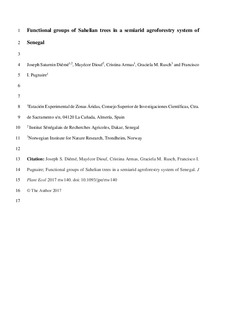| dc.contributor.author | Diémé, Joseph S. | |
| dc.contributor.author | Diouf, Mayécor | |
| dc.contributor.author | Armas, Cristina | |
| dc.contributor.author | Rusch, Graciela | |
| dc.contributor.author | Pugnaire, Francisco I. | |
| dc.date.accessioned | 2017-08-04T11:27:52Z | |
| dc.date.available | 2017-08-04T11:27:52Z | |
| dc.date.created | 2017-06-08T15:46:51Z | |
| dc.date.issued | 2017 | |
| dc.identifier.citation | Journal of Plant Ecology. 2017 | nb_NO |
| dc.identifier.issn | 1752-9921 | |
| dc.identifier.uri | http://hdl.handle.net/11250/2449914 | |
| dc.description.abstract | Aims Addressing plant responses to water stress is critical to understand the structure of plant communities in water-limited environments and to forecast their resilience to future changes in climate. In a semiarid agroforestry system in the Sahelian savannah of Leona (Senegal), we selected nine common tree species and explored their stress-resistance mechanisms. These species represent a variety of life forms and are of high regional socio-economic importance. We hypothesized that different species would show different suites of traits to cope with water stress and expected to identify functional groups differing in strategies to withstand water shortage. Methods Along a dry and a wet season, we monitored four traits reflecting above- and below-ground strategies of resource acquisition such as predawn leaf water potential (ψpd), specific leaf area (SLA), leaf thickness and leaf area index (LAI). We also measured two morphological traits: trunk diameter and tree height. LAI and ψpd were measured six times during the dry and rainy seasons, and the other traits were measured once. Important Findings We identified two functional classes subdivided into two functional groups of each class. The first class included deciduous and semi-deciduous species that generally had large SLA, low leaf thickness and small-to-intermediate inter-seasonal variations in ψpd. The second class included evergreen species of two functional groups that differ in SLA, leaf thickness and the magnitude of inter-seasonal variations of ψpd throughout the year. The four functional groups identified in this study represent plant strategies differing in their response to changing environmental conditions. Keywords: Acacia tortilis, Adansonia digitata, Balanites aegyptiaca, Celtis integrifolia, Combretum glutinosum, Faidherbia albida, functional traits, Neocarya macrophyla, Sclerocarya birrea, Tamarindus indica, water stress | nb_NO |
| dc.language.iso | eng | nb_NO |
| dc.subject | Acacia tortilis, Adansonia digitata, Balanites aegyptiaca,Celtis integrifolia, Combretum glutinosum, Faidherbia albida, functional traits, Neocarya macrophyla, Sclerocarya birrea,Tamarindus indica, water stress | nb_NO |
| dc.title | Functional groups of Sahelian trees in a semiarid agroforestry system of Senegal | nb_NO |
| dc.type | Journal article | nb_NO |
| dc.type | Peer reviewed | nb_NO |
| dc.description.version | acceptedVersion | nb_NO |
| dc.subject.nsi | VDP::Zoology and botany: 480 | nb_NO |
| dc.source.pagenumber | 10 | nb_NO |
| dc.source.journal | Journal of Plant Ecology | nb_NO |
| dc.identifier.doi | 10.1093/jpe/rtw140 | |
| dc.identifier.cristin | 1474800 | |
| dc.relation.project | EC/FP7/FUNCITREE Project | nb_NO |
| cristin.unitcode | 7511,2,0,0 | |
| cristin.unitname | Avdeling for terrestrisk økologi | |
| cristin.ispublished | true | |
| cristin.fulltext | postprint | |
| cristin.qualitycode | 1 | |
